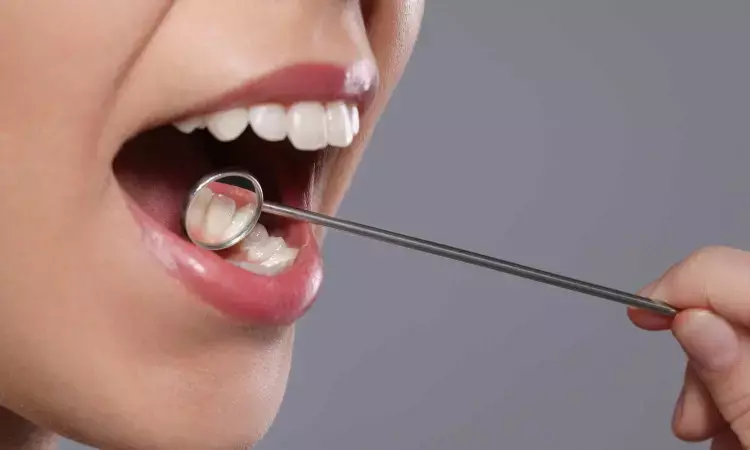- Home
- Medical news & Guidelines
- Anesthesiology
- Cardiology and CTVS
- Critical Care
- Dentistry
- Dermatology
- Diabetes and Endocrinology
- ENT
- Gastroenterology
- Medicine
- Nephrology
- Neurology
- Obstretics-Gynaecology
- Oncology
- Ophthalmology
- Orthopaedics
- Pediatrics-Neonatology
- Psychiatry
- Pulmonology
- Radiology
- Surgery
- Urology
- Laboratory Medicine
- Diet
- Nursing
- Paramedical
- Physiotherapy
- Health news
- Fact Check
- Bone Health Fact Check
- Brain Health Fact Check
- Cancer Related Fact Check
- Child Care Fact Check
- Dental and oral health fact check
- Diabetes and metabolic health fact check
- Diet and Nutrition Fact Check
- Eye and ENT Care Fact Check
- Fitness fact check
- Gut health fact check
- Heart health fact check
- Kidney health fact check
- Medical education fact check
- Men's health fact check
- Respiratory fact check
- Skin and hair care fact check
- Vaccine and Immunization fact check
- Women's health fact check
- AYUSH
- State News
- Andaman and Nicobar Islands
- Andhra Pradesh
- Arunachal Pradesh
- Assam
- Bihar
- Chandigarh
- Chattisgarh
- Dadra and Nagar Haveli
- Daman and Diu
- Delhi
- Goa
- Gujarat
- Haryana
- Himachal Pradesh
- Jammu & Kashmir
- Jharkhand
- Karnataka
- Kerala
- Ladakh
- Lakshadweep
- Madhya Pradesh
- Maharashtra
- Manipur
- Meghalaya
- Mizoram
- Nagaland
- Odisha
- Puducherry
- Punjab
- Rajasthan
- Sikkim
- Tamil Nadu
- Telangana
- Tripura
- Uttar Pradesh
- Uttrakhand
- West Bengal
- Medical Education
- Industry
0.3 mm thick Titanium Mesh Found Most Reliable for Guided Bone Regeneration, suggests study

Titanium meshes are widely used in guided bone regeneration (GBR) to maintain graft space and support new bone growth. Mesh thickness can influence not just mechanical stability but also stress transmission to graft and bone-factors that affect healing success. A new finite element analysis (FEA) study published in BMC Oral Health modeled titanium meshes of 0.1 mm, 0.2 mm, and 0.3 mm thickness over a mandibular defect to simulate masticatory loading and assess stress distribution.
Under a 30 N vertical load, the 0.1 mm mesh showed high max stress-981 MPa-suggesting risk of plastic deformation and graft damage, with graft stress reaching 35 MPa. The 0.2 mm version improved performance: mesh stress dropped to 452 MPa and graft stress to 11.6 MPa, offering a balance between strength and flexibility. The 0.3 mm mesh delivered optimal results, with mesh stress of 226 MPa, graft stress of 7.8 MPa, and bone stress of just 3.1 MPa-indicating superior load buffering. All bone stress remained below safety thresholds, but the 0.3 mm mesh clearly minimized risk to both graft and underlying bone. Although the 0.2 mm mesh may still be viable when surgical flexibility or cost is a concern, its graft stress values were marginally higher and require cautious use.
While thicker meshes deliver better mechanical protection, they may be harder to adapt intraoperatively and could increase soft tissue tension. The findings point to 0.3 mm as the most reliable thickness for optimal mechanical performance in GBR. The authors underscore the value of FEA for mesh design optimization, though they call for clinical validation since biomechanical models cannot account for biological factors like tissue integration or healing dynamics.
Reference:
Gedik, B., Kasapoğlu, M. B., Doğançalı, G. E., Uçkun, G. G., Cankaya, A. B., & Erdem, M. A. (2025). Effect of different titanium mesh thicknesses on mechanical strength and bone stress: A finite element study. BMC Oral Health, 25, Article 1341. https://doi.org/10.1186/s12903-025-06704-w
Dr. Shravani Dali has completed her BDS from Pravara institute of medical sciences, loni. Following which she extensively worked in the healthcare sector for 2+ years. She has been actively involved in writing blogs in field of health and wellness. Currently she is pursuing her Masters of public health-health administration from Tata institute of social sciences. She can be contacted at editorial@medicaldialogues.in.
Dr Kamal Kant Kohli-MBBS, DTCD- a chest specialist with more than 30 years of practice and a flair for writing clinical articles, Dr Kamal Kant Kohli joined Medical Dialogues as a Chief Editor of Medical News. Besides writing articles, as an editor, he proofreads and verifies all the medical content published on Medical Dialogues including those coming from journals, studies,medical conferences,guidelines etc. Email: drkohli@medicaldialogues.in. Contact no. 011-43720751


